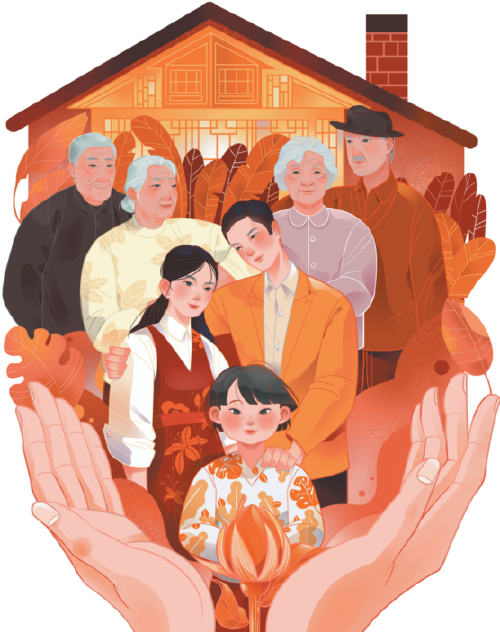Notification announcement
Taking a leaf out of Japan's book
Date:2022-11-26
China, which is now aging faster than any other country, can learn from the experience of the world's oldest society

The life expectancy of the world population is rising thanks to economic and social development, improved living standards, social security improvements and progress in science and technology, especially medical technology. But population aging is having negative consequences, such as labor shortages, lack of vigor in society and unsustainable social insurance.
That being said, population aging also creates opportunities for the development of human society. If we take minor stage as the first stage of life and the young and middle-aged years as the second stage, the post-retirement period can be viewed as the third stage of life. There's enormous human resource potential to be tapped in the older workforce. A growing number of elderly persons have maintained a very healthy life even after retirement — some are getting reemployed or starting their own businesses, while others are acquiring knowledge in universities for senior citizens, contributing to society and communities in different ways.
From a global perspective, despite a relatively late start in population aging, China is growing older faster and on a larger scale than any other country. Learning from the experience of countries that are at the forefront of population aging, implementing national strategies aimed at actively tackling challenges from population aging and blazing a new trail in addressing population aging with Chinese characteristics are arduous and urgent tasks that China must undertake.
Japan is an important country that China can learn from when addressing the aging problem. Japan's population aging started in the 1970s and has since become an increasingly severe problem. Today, its "super-aged" society is the oldest in the world. By Sept 15, 2021, 29.1 percent of the Japanese population was aged 65 or above. On the other hand, Japan also has one of the highest life expectancies in the world at 84 and the country is also home to a record number of centenarians. Japan is entering an era of centenarians.
As population aging advances, the Japanese government and people have been actively coping with problems associated with it, accumulating rich experience in addressing the aging problem, both positive and negative.
Despite the difference in social systems, China and Japan have much in common in demographic structural changes, features of population aging, and attitudes toward supporting the elderly. Japan's policies and solutions for coping with population aging, in particular measures for "active aging", provide China with important references.
To start with, Japan has been advocating that older persons are invaluable assets for society, humanity and sustainable development and that they are builders, supporters and undertakers of society. Society should create opportunities for older adults to freely choose their ways of life in old age. When their health conditions deteriorate and they need help, they should have access to sufficient protection, security and care to live a dignified life; when they wish to give full play to their capabilities, society should create opportunities to help and support them to tap their fullest potential and achieve self-worth.
Based on the demographic transition, Japan has continuously optimized laws and regulations on healthcare services for the elderly, improved its elderly medical and healthcare service system, reformed the nursing-care insurance system, advanced the "combination of medical and healthcare", and promoted gradual improvements in health services for the elderly. In particular, the Long-term Care Insurance Act that came into effect in Japan in 2000 has greatly mitigated the burden on family caregivers for older adults, effectively mobilized resources of the market, government and non-profit organizations, reduced the government's fiscal burden and satiated the diversified demands for elder care services.
Japan has also tapped seniors as a human resource, thus improving the employment environment for older adults. The public employment security offices of all prefectures have set up a special window for employment consultation and assistance for the elderly.
Since the turn of the century, the Japanese government has unveiled a number of policies and regulations on postponing mandatory retirement ages. It's worth mentioning that the postponement and re-employment policies are not mandated by government administrative orders, but rather, are gradually induced by government subsidies and incentives. Some Japanese financial companies provide concessional loans for seniors and provide subsidies for their business startups, such as rental and decoration, to encourage them to start up their own businesses.
In 2020, Japan's older adult population, those aged above 65, accounted for 13.4 percent of the country's total workforce, a relatively high ratio worldwide. It's been proven that fully tapping the human capital among older people and supporting their social engagement can, to a certain extent, counteract the negative effects of population aging.
Since the late 1990s, Japan's NGOs have been booming like mushrooms after rain. Some of them have opened coffee shops, canteens and salons for the elderly in local communities, providing a platform for seniors to communicate and socialize with each other. These facilities have also helped older adults get out of their homes and take part in such careers as community building, caring for young children, environmental protection, and elderly care, etc.
The non-profit organizations in Hokkaido, that target a large number of seniors living alone, have set up community canteens to deliver meals for them and held elderly salons to promote their social engagement. A lot of healthy older adults have joined the non-profit and community volunteer organizations, becoming supporters and undertakers of community building.
Last but not least, senior citizen education, an important part of lifelong education and learning, has satisfied the needs of the elderly for knowledge, enriched their life and enhanced the level of knowledge of skills.
In Japan, education for senior citizens is mainly provided by welfare and educational institutions across Japanese prefectures, districts, cities, towns, municipalities and wards as well as non-government non-profit organizations or non-government institutions, with great variety in school-running subjects and education models.
Some higher education institutions in Japan integrate their degree education with senior citizen education by setting up public lectures for the elderly to provide degree education opportunities for them.
(Source: China Daily)

